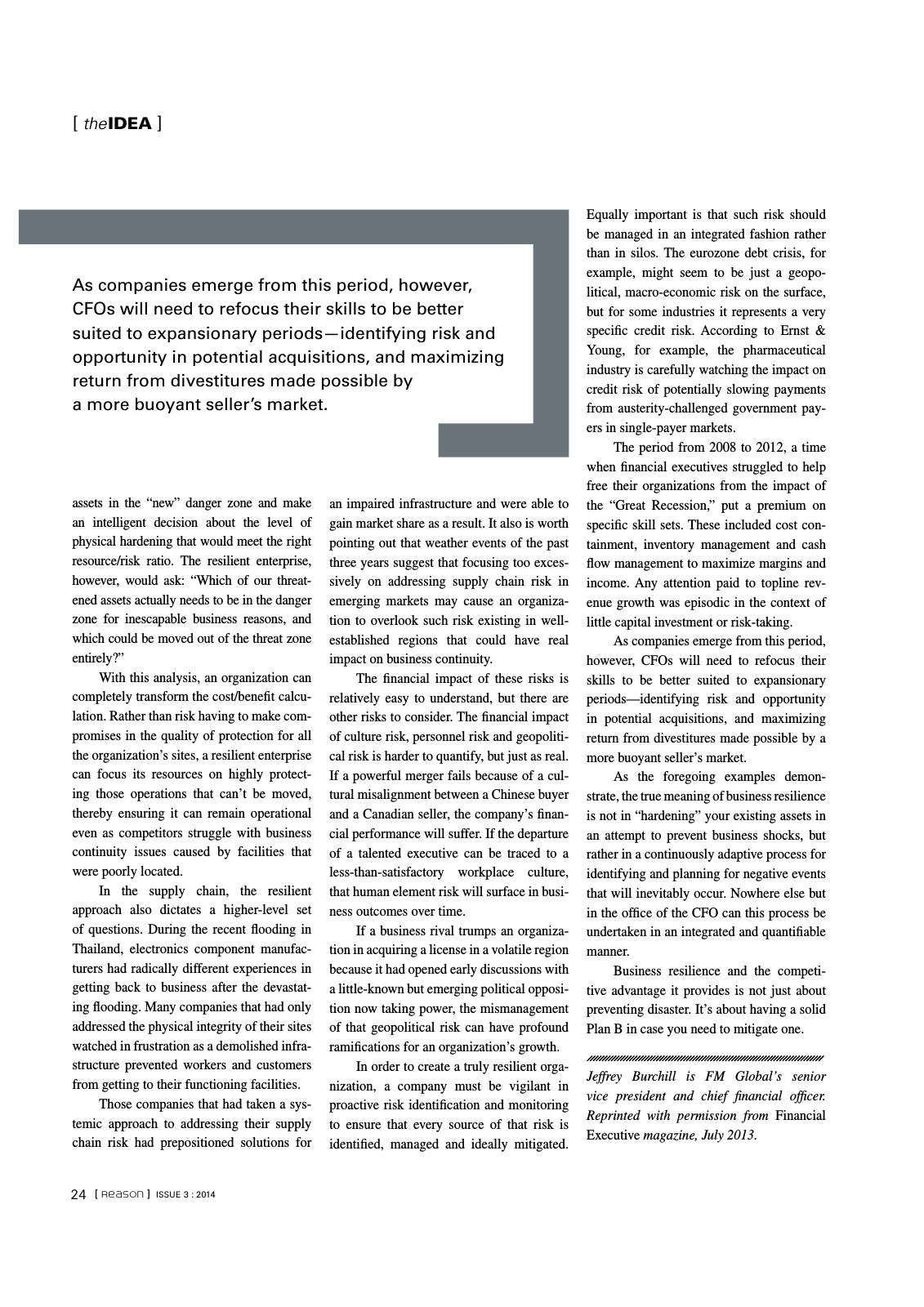Reason Magazin 2014Q3 Seite 24
Hinweis: Dies ist eine maschinenlesbare No-Flash Ansicht.Klicken Sie hier um zur Online-Version zu gelangen.
Inhalt
assets in the new danger zone and make an intelligent decision about the level of physical hardening that would meet the right resource risk ratio The resilient enterprise however would ask Which of our threat ened assets actually needs to be in the danger zone for inescapable business reasons and which could be moved out of the threat zone entirely With this analysis an organization can completely transform the cost benefit calcu lation Rather than risk having to make com promises in the quality of protection for all the organization s sites a resilient enterprise can focus its resources on highly protect ing those operations that can t be moved thereby ensuring it can remain operational even as competitors struggle with business continuity issues caused by facilities that were poorly located In the supply chain the resilient approach also dictates a higher level set of questions During the recent flooding in Thailand electronics component manufac turers had radically different experiences in getting back to business after the devastat ing flooding Many companies that had only addressed the physical integrity of their sites watched in frustration as a demolished infra structure prevented workers and customers from getting to their functioning facilities Those companies that had taken a sys temic approach to addressing their supply chain risk had prepositioned solutions for an impaired infrastructure and were able to gain market share as a result It also is worth pointing out that weather events of the past three years suggest that focusing too exces sively on addressing supply chain risk in emerging markets may cause an organiza tion to overlook such risk existing in well established regions that could have real impact on business continuity The financial impact of these risks is relatively easy to understand but there are other risks to consider The financial impact of culture risk personnel risk and geopoliti cal risk is harder to quantify but just as real If a powerful merger fails because of a cul tural misalignment between a Chinese buyer and a Canadian seller the company s finan cial performance will suffer If the departure of a talented executive can be traced to a less than satisfactory workplace culture that human element risk will surface in busi ness outcomes over time If a business rival trumps an organiza tion in acquiring a license in a volatile region because it had opened early discussions with a little known but emerging political opposi tion now taking power the mismanagement of that geopolitical risk can have profound ramifications for an organization s growth In order to create a truly resilient orga nization a company must be vigilant in proactive risk identification and monitoring to ensure that every source of that risk is identified managed and ideally mitigated Equally important is that such risk should be managed in an integrated fashion rather than in silos The eurozone debt crisis for example might seem to be just a geopo litical macro economic risk on the surface but for some industries it represents a very specific credit risk According to Ernst Young for example the pharmaceutical industry is carefully watching the impact on credit risk of potentially slowing payments from austerity challenged government pay ers in single payer markets The period from 2008 to 2012 a time when financial executives struggled to help free their organizations from the impact of the Great Recession put a premium on specific skill sets These included cost con tainment inventory management and cash flow management to maximize margins and income Any attention paid to topline rev enue growth was episodic in the context of little capital investment or risk taking As companies emerge from this period however CFOs will need to refocus their skills to be better suited to expansionary periods identifying risk and opportunity in potential acquisitions and maximizing return from divestitures made possible by a more buoyant seller s market As the foregoing examples demon strate the true meaning of business resilience is not in hardening your existing assets in an attempt to prevent business shocks but rather in a continuously adaptive process for identifying and planning for negative events that will inevitably occur Nowhere else but in the office of the CFO can this process be undertaken in an integrated and quantifiable manner Business resilience and the competi tive advantage it provides is not just about preventing disaster It s about having a solid Plan B in case you need to mitigate one As companies emerge from this period however CFOs will need to refocus their skills to be better suited to expansionary periods identifying risk and opportunity in potential acquisitions and maximizing return from divestitures made possible by a more buoyant seller s market Jeffrey Burchill is FM Global s senior vice president and chief financial officer Reprinted with permission from Financial Executive magazine July 2013 the IDEA 24 Reason ISSUE 3 2014
